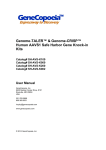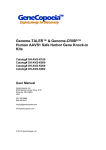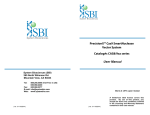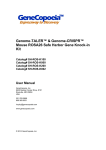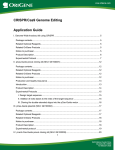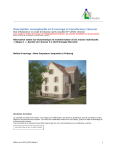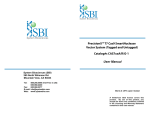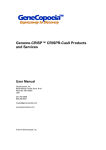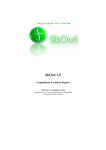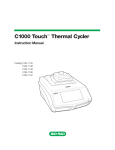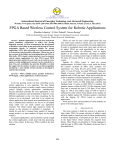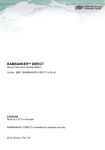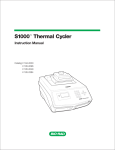Download User Manual - System Biosciences
Transcript
AAVS1 TALE-Nuclease Kit Catalog#s GE60xA-1 User Manual Store at -20°C upon receipt (ver. ver. 1-010213) A limited-use label license covers this product. By use of this product, you accept the terms and conditions outlined in the Licensing and Warranty Statement contained in this user manual. AAVS1 TALE Nuclease Kit Cat. #s GE60xA-1 Contents I. Introduction .............................................................................2 A. Genome targeting using TALE technology .........................2 B. TALE-Nuclease based targeting of AAVS1 locus ...............2 C. Detailed information and vector maps for AAVS1 TALEN kit 3 D. List of Components .............................................................4 E. II. Additional Materials Required .............................................4 Validation Data for AAVS1 TALE-Nuclease kit .......................5 III. Protocol for Genome Engineering of Target Cells using AAVS1 TALE-Nuclease kit A. General Comments ..............................................................6 B. Cloning into pAAVS1D empty donor vector .........................6 C. Co-transfection of TALE-Nuclease pairs and donor plasmids D. Characterization of TALE-Nuclease modified and HDR recombinant cells 9 IV. References .............................................................................12 V. Technical Support ...................................................................13 VI. Licensing and Warranty Statement ........................................13 888-266-5066 (Toll Free) 650-968-2200 (outside US) Page 1 8 6 System Biosciences (SBI) I. User Manual Introduction A. Genome targeting using TALE technology Recent advances in targeted genome engineering have offered researchers new approaches to specifically address inherent issues with traditional gene targeting and editing approaches in mammalian cells. The current “gold-standard” technology for mammalian gene targeting, zinc-finger nucleases (ZFN), has demonstrated that it can selectively target artificial and endogenous loci in human ESC and iPSC cells and deliver gene correction by homology-directed recombination (HDR) (Zou J et al. 2009, Hockemeyer D et al. 2009). However, the need for extensive empirical validation and intellectual property-associated costs of developing novel ZFN modules has hampered widespread adoption of the technology. TALEs (Transcriptional Activator-Like Effectors) are an alternative to ZFNs for site-specific gene targeting. Originally identified in the plant pathogen Xanthomonas sp., they are transcriptional factors that specifically bind to a target DNA sequence. Each TALE protein has a distinct modular structure which consists of a N-terminal DNA-binding domain and a C-terminal effector domain. The DNA-binding domain of TALEs contain many modules arranged in tandem, with each module containing ~33-35 amino acids. Each module contains nearly the same sequences with exception of two highly variable di-amino acid residues (RVDs) that specify the DNA base to be recognized. There are four combinations of these RVDs, each encoding for a specific DNA base (A,T,G,C) to be targeted. By addition of an endonuclease to the TALE effector domain, it is possible to generate a pair of TALE nuclease constructs that bind to target DNA in a sequence-specific manner and cut regions in between the targeted sequences. The resulting double strand break is then repaired through the non-homologous end-joining (NHEJ) pathway. Due to the error-prone nature of this pathway, insertions and deletions (“indels”) are often found in sites that are cut by the TALEN pair. This results in the concomitant disruption of the targeted gene and loss of gene function. TALE-Nucleases can be theoretically designed against any gene sequence present in metazoan genomes. It has been successfully utilized to target and disrupt various loci in cultured human cell lines (Cermak et al, 2011, Miller et al. 2011). As with ZFNs, TALE-Nucleases can be utilized in conjunction with donor plasmid(s) bearing homologous sequences to the regions immediately upstream and downstream of the TALE-Nuclease cut site, allowing for gene correction or insertion of gene sequences driven by homology-directed recombination (HDR). B. TALE-Nuclease based targeting of AAVS1 locus A crucial application of TALE-Nuclease technology has been targeted genome engineering of human pluripotent cells such as hESCs and iPSCs, as these cells have the capacity for many broad-based applications in studying human disease. Traditional viral-mediated gene transfer into these cells has often led to variable and sometimes unpredictable results, namely transgene silencing and/or acquisition of tumorigenic phenotypes through insertional mutagenesis. To address these shortcomings, TALE-Nuclease pairs have been designed to target the human AAVS1 (also known as PPP1R12C) locus, a well-validated “safe harbor” in the human genome (Sadelain et al. 2011). A safe harbor is defined as a region of the genome that is considered to be both transcriptionally active and its disruption does not lead to discernable phenotypic effects. The targeting of the AAVS1 locus by TALE-Nuclease pairs and homologous recombination of donor plasmids bearing GFP or antibiotic selection markers have been previously demonstrated in human ESC and iPS cells. The targeting efficiencies within these two cell types has been reported as ranging between 40-80% (Hockemeyer et al. 2011). Notably, all successfully targeted cells showed expression of GFP as well as several pluripotency markers (e.g. Oct4, Sox2, TRA-1-60). These cells retained the ability to differentiate into tissue representing all three germ layers, suggesting that targeting and modification of the AAVS1 locus results in stable transgene expression and no discernible “off-target” phenotypes. Page 2 ver. 1-010213 www.systembio.com AAVS1 TALE Nuclease Kit Cat. #s GE60xA-1 Fig. 1. Schematic of the AAVS1 TALE-Nuclease Pair and its cognate target sequence. C. Detailed information and vector maps for AAVS1 TALEN kit SBI’s AAVS1 TALE-Nuclease kit (Cat#GE600A-1) provides the researcher with a well-validated pair of TALENuclease constructs, pZT-AAVS1-L1/R1 (Cat#GE601A-1), designed to efficiently cut at a defined site on the AAVS1 locus. The TALE-Nuclease constructs are driven by a CMV promoter, which is active in most cell types. The kit also contains a positive control donor vector (pAAVS1D-CMV-RFP-EF1a-copGFP-T2A-Puro, Cat#GE603A-1) and cloning (empty) donor vector (pAAVS1D-PGK-MCS-EF1a-copGFP-T2A-Puro, Cat#GE602A-1) which contain homologous sequences to ~800bp upstream and downstream of the AAVS1 TALE-Nuclease targeting sites. Co-transfection of the TALE-Nuclease vectors and the positive control donor vector can be used to validate TALE-Nuclease cutting and subsequent homology-directed repair (HDR) in target cells of interest by detection of RFP & GFP markers and/or puromycin resistance. Additionally, validated PCR primer pairs for 5’ and 3’ Junction PCR Assays are provided as 10 µM mixes for detection of specific integration of the positive control donor plasmid sequence at the AAVS1 locus. Fig. 2. Vector maps for pZT-AAVS1-L1/R1, pAAVS1D-CMV-RFP-EF1a-copGFP-T2A-Puro positive control donor vector, and pAAVS1D-PGK-MCS-EF1a-copGFP-T2A-Puro donor cloning vector. 888-266-5066 (Toll Free) 650-968-2200 (outside US) Page 3 System Biosciences (SBI) User Manual D. List of Components List of Components for Catalog # GE600A-1 (AAVS1 TALE-Nuclease Kit) CAT. NO DESCRIPTION QTY pZT-AAVS1-L1/R1 vectors (L+R GE601A-1 10 µg each TALEN constructs) pAAVS1D-PGK-MCS-EF1aGE602A-1 copGFP-T2A-Puro cloning donor 10 µg vector pAAVS1D-CMV-RFP-EF1aGE603A-1 copGFP-T2A-Puro positive control 10 µg donor vector 5’ and 3’ AAVS1 Positive Control GE603PR-1 Donor Vector Primer Mixes for 100 µl each Junction PCR Assays (10 µM) E. Additional Materials Required a) LB Agar and Broth containing 50 µg/ml kanamycin or carbenicillin b) Any high-transformation efficiency RecA- and EndA- E.coli competent cells c) Dulbecco’s Modified Eagle’s Medium (D-MEM) high glucose with sodium pyruvate and glutamine (Invitrogen, Cat. # 11995073) d) Lipofectamine 2000 transfection reagent (Invitrogen, Cat. # 11668019) e) Qiagen EndoFree Plasmid Maxi Kit (Qiagen, Cat. # 12362) f) Qiagen DNeasy Blood and Tissue Kit (Qiagen, Cat. # 69504) g) iProof High-Fidelity DNA Polymerase (BioRad, Cat. # 172-5301) h) Fetal Bovine Serum (Invitrogen, Cat. # 16000036) i) Penicillin/Streptomycin (Invitrogen, Cat. # 15070063) j) Trypsin-EDTA (Sigma, Cat. # T3924) h) 6-well Tissue Culture Plates and Related Tissue Culture Supplies i) Other specific media and additives specific for cell type of interest j) **Optional** - For difficult-to-transfect cells, the use of an electroporation system (e.g. Lonza’s NucleoFector or Invitrogen’s Neon system) is highly recommended Page 4 ver. 1-010213 www.systembio.com AAVS1 TALE Nuclease Kit II. Cat. #s GE60xA-1 Validation Data for AAVS1 TALE-Nuclease Kit Fig. 3. Transfection data demonstrating the functionality of the pZT-AAVS1-TALE Nuclease pair and HDR of Positive Control Donor Vector in HEK293T cells pZT-AAVS1-TALE Nuclease+Donor Vector Donor Vector only 0.01% 8.1% Fig. 4. Flow cytometry data showing % of GFP+ cells after transfection of pZT-AAVS1-TALE Nuclease pair and Positive Control Donor Vector compared to Donor Vector only in HEK293T cells (Data provided courtesy of Dr. Jizhong Zou, NIH Center For Regenerative Medicine) Uncut DNA 888-266-5066 (Toll Free) 650-968-2200 (outside US) Page 5 System Biosciences (SBI) User Manual pZT‐AAVS1‐TALEN T7E1 nuclease cut DNA ~25% of DNA cut by T7E1 nuclease Fig. 5. Agilent BioAnalyzer results for T7E1 nuclease assay showing % of DNA that has undergone NHEJ after transfection of pZT-AAVS1-TALE Nuclease pair in HEK293T cells Data provided courtesy of Dr. Jizhong Zou, NIH Center For Regenerative Medicine) III. Protocol for Genome Engineering of Target Cells using AAVS1 TALE-Nuclease Kit A. General Comments We recommend propagation of the plasmids provided in the AAVS1 TALE-Nuclease kit prior to starting the experiments. The plasmids can be transformed using standard conditions suitable in any RecA- and EndA- E.coli competent cell. For the cells transformed with pZT vectors, we suggest plating 50-200µl of transformed cells on fresh LBKanamycin plates (50µg/ml). The pAAVS1 Donor vectors should on LB-Carbenicillin plates (50µg/ml). Incubate the plates at 37°C overnight. Colonies picked from the transformation can be grown at 37°C overnight in ~200ml of LB media containing either 50µg/ml of kanamycin (pZT vectors) or carbenicillin (pAAVS1 Donor vectors). After overnight growth, plasmid DNA can be harvested from culture using an endotoxin-free DNA plasmid maxiprep kit. For confirmation of the plasmid, we recommend performing restriction digestion analysis or direct sequencing to confirm integrity of the amplified plasmids. B. Cloning into pAAVS1D empty donor vector For rapid and efficient cloning of any insert into the donor vector, we recommend SBI’s Cold Fusion Cloning Kit as a ligase and restriction enzyme-free cloning method. More details can be found here: (http://www.systembio.com/molecular-tools/cold-fusion-cloning/overview) For standard cloning strategies, use the following protocol: 1. Ligation of insert into vector a) Dilute gel-purified, digested vector to 10ng/µl b) Set up 10µl ligation reactions for each control and test samples as below: Page 6 ver. 1-010213 www.systembio.com AAVS1 TALE Nuclease Kit Volume 1.0 µl 7.0 µl 1.0 µl 1.0 µl 10.0 µl Cat. #s GE60xA-1 Item pAAVS1D empty cloning vector DNA insert (~30-50 ng) or water control 10X T4 DNA ligase buffer T4 DNA Ligase (40 U/µl) Total Reaction Volume c) Incubate reactions at 250C for 1-2 hours (sticky-end ligation) or O/N at 160C (for blunt-end ligation) 2. Transform E. coli with the ligation product Transform competent cells (with a transformation efficiency of at least 1x109 colonies/g pUC19) with the whole ligation reaction (10 l) following the protocol provided with the competent cells. Plate the transformed bacteria on LB-Ampicillin/Carbencillin agar plates. 3. Identify clones with the correct insert a) Depending on the ratio of colony numbers for the cDNA sample vs. the negative control sample, randomly pick 5 or more well-isolated colonies and grow each clone in 100 l of LB Broth with 75 g/ml ampicillin/carbenicillin at 37°C for 2 hours with shaking. b) Use 1 l of each bacterial culture for screening DNA inserts by PCR and continue to grow the culture for another 4 hours. Store the culture at 4°C. c) Prepare a PCR Master Mix with PCR primers flanking the insert: 1 rxn 0.5 l 0.5 l 0.5 l 2.5 l 19.5 l 0.5 l 24.0 l 10 rxn 5 l 5 l 5 l 25 l 195 l 5 l 240 l Composition PCR primer 1 (10 M) PCR primer 2 (10 M) 50X dNTP mix (10 mM of each) 10X PCR Reaction Buffer Nuclease-free water Taq DNA polymerase (approx. 5 U/l) Total volume d) Mix the master mix very well and aliquot 24 l into each well of 96-well PCR plate or individual tubes. e) Add 1 l of each bacterial culture from step (b) into each well (or tube). f) Proceed with PCR using the following program: 94°C, 4 min 94°C, 0.5 min, then 68°C, 1 min/1 kb* 68°C, 3 min 1 cycle 25 cycles 1 cycle * Depending on the size of final PCR product, use a shorter or longer time. g) Take 5 l of the PCR reaction and run it on a 1.2% agarose/EtBr gel in 1X TAE buffer to identify clones with correct insert. 888-266-5066 (Toll Free) 650-968-2200 (outside US) Page 7 System Biosciences (SBI) User Manual 4. Grow a positive clone containing insert in an appropriate amount of LB-Ampicillin/Carbenicillin Broth, and purify the construct using an endotoxin-free plasmid purification kit. equence verification of the insert is optional. C. Co-transfection of TALE-Nuclease pairs and donor plasmids 1) Plate ~100,000 to 300,000 cells/well in a 6-well plate according to established recommended conditions for cell type(s) being transfected. Include wells for the following: a) TALE-Nuclease + positive control donor vector b) Positive control donor vector only c) TALE-Nuclease + cloning donor vector d) Cloning donor vector only 2) Next day, prepare transfection complexes of TALE-Nuclease vectors and donor plasmids using a suitable transfection reagent such as SBI’s PureFection or Lipofectamine 2000+Plus reagent according to the manufacturer’s recommended instructions. Leave the transfection complex on the cells for >6 hours. Example: For HEK293T cells using Lipofectamine 2000 reagent, transfect 0.5µg of each pZT-AAVS1L1 and pZT-AAVS1-R1 vectors (1µg total) and 1µg of donor vector. Tech Notes: a) Since transfection efficiencies vary across different cell lines, we recommend optimizing the input of TALE-Nuclease vectors to donor vectors for best results. We recommend starting with a 1:1 ratio (e.g. 1µg of donor HR plasmid and 0.5µg of each TALE Nuclease plasmid). b) For optimal results, we recommend complexing of DNA with transfection reagent in serum- and antibiotic-free media and cells growing in complete media (e.g. DMEM/F12+10% FBS w/o antibiotics). c) For hard-to-transfect cells (e.g. primary, stem, hematopoietic), it may be advisable to utilize a nonpassive transfection method such as NucleoFection (Lonza) or Neon system (Life Technologies). Please follow recommended transfection guidelines provided by the manufacturer for specific cell type(s) being transfected. 3) 24 hours post-transfection, remove transfection media and split the cells 1:10 and 1:20 in complete growth media w/antibiotics. Plate cells into 6-well plates and save a set of plate(s) for characterization of samples by junction-PCR assay (see below). Allow cells to recover for 24 hours. 4) Begin puromycin selection 48 hours post-transfection. For 293T cells, the recommended concentration of puromycin is 1 µg/ml. Tech Note: The effective working puromycin concentration for a target cell line can be determined by establishing a kill-curve on untransfected cells. The concentration of puromycin (typical working range of 0.5g-5g/ml) that kills >90% of cells after 48hours of selection is the correct dose for the cells being selected. Page 8 ver. 1-010213 www.systembio.com AAVS1 TALE Nuclease Kit Cat. #s GE60xA-1 D. Characterization of TALE-Nuclease modified and HDR recombinant cells 1) Assay for TALE-Nuclease cutting and HDR of donor vectors on samples as follows: a) TALE-Nuclease + Positive control donor: Select cells in Puromycin for 7-10 days, resulting colonies should be RFP & GFP positive. b) Positive control donor only: Select cells in Puromycin for 7-10 days, very few colonies (if any) should be seen relative to positive control donor + TALE-Nuclease (Sample a). Presence of PuroR, RFP/GFP+ colonies indicates frequency of random integration events. c) TALE-Nuclease + Cloning donor vector Select cells in Puromycin for 7-10 days, colonies should be GFP positive. Expression of insert may be detected by qPCR or Western blot. d) Cloning donor vector only Select cells in Puromycin for 7-10 days, very few colonies (if any) should be seen relative to cloning donor vector + TALE-Nuclease (Sample c). Presence of PuroR, GFP+ colonies indicates frequency of random integration events. 2) For confirmation of donor vector integration specifically at the AAVS1 target locus, junction-PCR can be performed using PCR primer pairs that flank the 5’ AAVS1 homology arm (5’ AAVS1-HA-L) and 3’ AAVS1 homology arm (3’AAVS1-HA-R). Junction-PCR primer pair sequences will depend on the donor vector used. The GE600A-1 Kit includes the Junction-PCR primer pairs for use with the Positive Control Donor Vector. 3’ Junction-PCR primer pair included in the kit can also be used to validate targeted integration of the Cloning Donor Vector. 3) Positive Control Donor Vector Junction-PCR a) Primer Sequences 5’ AAVS1 Positive Control Donor - Forward Primer: 5’ AAVS1 PC-F: 5’ CCGGAACTCTGCCCTCTAAC 3’ 5’ AAVS1 Positive Control Donor - Reverse Primer: 5’ AAVS1 PC-R: 5’ CCCGTGAGTCAAACCGCTAT 3’ 3’ AAVS1 Positive Control Donor - Forward Primer: 3’ AAVS1 PC-F: 5’ AGCTATCTGGTCTCCCTTCC 3’ 3’ AAVS1 Positive Control Donor - Reverse Primer: 3’ AAVS1 PC-R: 5’ TCCTGGGATACCCCGAAGAG 3’ The primers are provided as mixes (F/R primers) at 10µM. Validation of either the 5’ or 3’ homology arms for donor integration is usually sufficient; however, both arms can be done for additional confirmation. b) Protocol Details for 5’ AAVS1 Positive Control Donor Junction-PCR Assay: 888-266-5066 (Toll Free) 650-968-2200 (outside US) Page 9 System Biosciences (SBI) User Manual i. Isolate genomic DNA from positive control cells using a suitable genomic DNA miniprep kit for extraction of gDNA from cultured cells. Please follow manufacturer’s recommended protocol. ii. Perform Junction-PCR (PCR reaction below) Reagent TALEN cut + positive control donor Positive control donor only 1 µl N/A N/A 1 µl 5 µl 0.5 µl 5 µl 0.5 µl 1.25 µl 1.25 µl 0.25 µl 0.25 µl 17 µl 25 µl 17 µl 25 µl TALEN cut + Donor plasmid DNA (200 ng/µl) Donor plasmid only DNA (200 ng/µl) 5X PCR Buffer 10 mM dNTPs 10 µM 5’ AAVS1PC PCR Primer Mix iProof DNA Polymerase (2 U/µl) PCR-grade water Total Volume iii. Proceed with Touchdown PCR protocol below: 98°C, 30 sec 98°C, 15 sec o 68 to 63°C (-0.5 /cycle), 30 sec 72°C, 40 sec 98°C, 15 sec 63°C, 30 sec 72°C, 40 sec 72°C, 1 min 10 cycles 30 cycles Hold at 4°C iv. Run the PCR reaction out on a 1.5% agarose/EtBr gel in 1X TBE buffer to confirm the Junction-PCR results. Sample data can be found below the 3’ Junction-PCR protocol (next section). c) Protocol Details for 3’ AAVS1 Positive Control Donor Junction-PCR Assay : i. Perform Junction-PCR (PCR reaction below) Page 10 ver. 1-010213 www.systembio.com AAVS1 TALE Nuclease Kit Reagent Cat. #s GE60xA-1 TALEN cut + positive control donor Positive control donor only 1 µl N/A N/A 1 µl 5 µl 0.5 µl 5 µl 0.5 µl 1.25 µl 1.25 µl 0.25 µl 0.25 µl 17 µl 25 µl 17 µl 25 µl TALEN cut + Donor plasmid DNA (200 ng/µl) Donor plasmid only DNA (200 ng/µl) 5X PCR Buffer 10 mM dNTPs 10 µM 3’ AAVS1PC PCR Primer Mix iProof DNA Polymerase (2 U/µl) PCR-grade water Total Volume ii. Proceed with a Touchdown PCR protocol below: 98°C, 1 min 98°C, 20 sec o 66 to 61°C (-0.5 /cycle), 30 sec 72°C, 2 min* 98°C, 20 sec 61°C, 30 sec 72°C, 2 min* 72°C, 5 min 10 cycles 30 cycles Hold at 4°C *Indicates that long extension is needed for PCR product to be made. iii. Run the PCR reaction out on a 1.5% agarose/EtBr gel in 1X TBE buffer to confirm Junction-PCR results. Expected size of the amplicon will be ~1.3kb. Sample results for 5’ and 3’ Junction-PCR Assay shown below: 888-266-5066 (Toll Free) 650-968-2200 (outside US) Page 11 System Biosciences (SBI) User Manual Fig. 6. Junction PCR data demonstrating the functionality of the pZT-AAVS1-TALE Nuclease pair and HDR of Positive Control Donor Vector in HEK293T cells. Genomic DNA samples (200 ng) of human 293T cells were analyzed for AAVS1 targeted homologous recombination using junction PCR. AAVS1 Donor plus AAVS1 TALE-Nuclease pair (Lane 1 and 2) and Donor alone without TALE-Nuclease pair (Lane 3 and 4) were tested after 5 days under puromycin selection. The expected 1.1kb fragment for 5’ Junction-PCR and the expected 1.5kb fragment for 3’ Junction-PCR are both clearly observed in the AAVS1 Donor plus TALENuclease pair lanes. IV. References Zou, J. et al. 2009. Gene targeting of a disease-related gene in human induced pluripotent stem and embryonic stem cells. Cell Stem Cell. 2009 Jul 2;5(1):97-110 Hockemeyer, D. et al. 2009. Efficient targeting of expressed and silent genes in human ESCs and iPSCs using zincfinger nucleases. Nat Biotechnol. 2009 Sep;27(9):851-7 Cermak, T. et al. 2011. Efficient design and assembly of custom TALEN and other TAL effector-based constructs for DNA targeting. Nucleic Acids Res. 2011 Jul;39(12):e82. Miller, J. et al. 2011. A TALE nuclease architecture for efficient genome editing. Nat Biotechnol. 2011 Feb;29(2):1438. Sadelain, M. et al. 2011. Safe harbours for the integration of new DNA in the human genome. Nat Rev Cancer. 2011 Dec 1;12(1):51-8. Hockemeyer, D. et al. 2011. Genetic engineering of human pluripotent cells using TALE nucleases. Nat Biotechnol. 2011 Jul 7;29(8):731-4. Page 12 ver. 1-010213 www.systembio.com AAVS1 TALE Nuclease Kit V. Cat. #s GE60xA-1 Technical Support For more information about SBI products or to download manuals in PDF format, please visit our website: http://www.systembio.com For additional information or technical assistance, please call or email us at: [email protected] 650-968-2200 VI. Licensing and Warranty Statement Acknowledgement: Design of the pZT-AAVS1-L1/R1 and pAAVS1D-CMV-RFP-EF1α-copGFP-T2A-Puro vectors was performed by Dr. Jizhong Zou of the NIH Center for Regenerative Medicine, a Common Fund initiative of the U.S. National Institutes of Health. Limited Use License Use of the AAVS1 TALE-Nuclease Kit (i.e., the “Product”) is subject to the following terms and conditions. If the terms and conditions are not acceptable, return all components of the Product to System Biosciences (SBI) within 7 calendar days. Purchase and use of any part of the Product constitutes acceptance of the above terms.The purchaser of the Product is granted a limited license to use the Product under the following terms and conditions: The Product shall be used by the purchaser for internal research purposes only. The Product is expressly not designed, intended, or warranted for use in humans or for therapeutic or diagnostic use. The Product may not be resold, modified for resale, or used to manufacture commercial products without prior written consent of SBI. This Product should be used in accordance with the NIH guidelines developed for stem cell research. Purchase of the product does not grant any rights or license for use other than those explicitly listed in this Licensing and Warranty Statement. Use of the Product for any use other than described expressly herein may be covered by patents or subject to rights other than those mentioned. SBI disclaims any and all responsibility for injury or damage which may be caused by the failure of the buyer or any other person to use the Product in accordance with the terms and conditions outlined herein. Limited Warranty SBI warrants that the Product meets the specifications described in this manual. If it is proven to the satisfaction of SBI that the Product fails to meet these specifications, SBI will replace the Product or provide the purchaser with a refund. This limited warranty shall not extend to anyone other than the original purchaser of the Product. Notice of nonconforming products must be made to SBI within 30 days of receipt of the Product. SBI’s liability is expressly limited to replacement of Product or a refund limited to the actual purchase price. SBI’s liability does not extend to any damages arising from use or improper use of the Product, or losses associated with the use of additional materials or reagents. This limited warranty is the sole and exclusive warranty. SBI does not provide any other warranties of any kind, expressed or implied, including the merchantability or fitness of the Product for a particular purpose. SBI is committed to providing our customers with high-quality products. concerns about any SBI products, please contact us at (888) 266-5066. © 2013 System Biosciences (SBI). 888-266-5066 (Toll Free) 650-968-2200 (outside US) Page 13 If you should have any questions or














